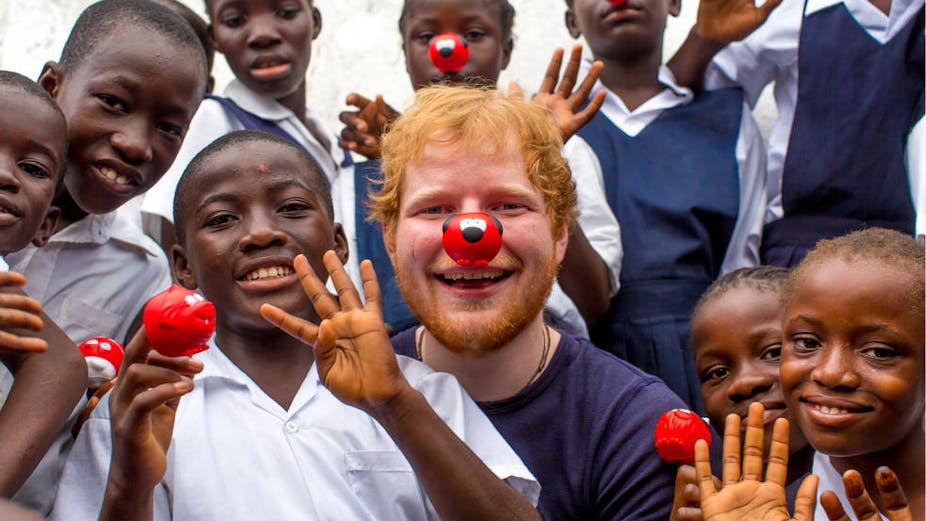On the eve of Sport Relief 2018, Liz Warner – the head of the TV fundraiser – announced a new approach to its on-location films. The decision followed accusations of “poverty tourism” and “poverty porn” which were made by a charity watchdog against three films produced for Comic Relief and the Disasters Emergencies Committee in 2017.
Comic Relief also runs the Sport Relief appeal and will now move away from the well-known format in which celebrities appear centre stage to learn of the hardships of communities and to explain to viewers how their donations might ease the people’s suffering. These films have undoubtedly helped the charity to raise in excess of £1 billion over the last 30 years. The stars are often clearly moved by their experiences, and few would question their sincerity.
But, as the MP David Lammy recently reminded us, these films are laden with imperialistic stereotypical notions of Africans as “victims to be pitied” rather than “as equals to be respected”. Lammy thinks that appeals should be based on people explaining their situation in their own terms. This would help dislodge stereotypes and enable discussion of the underlying structural problems of free trade and governance, both within African nations and in their relation to the rest of the world.
Choosing to reduce celebrity endorsements carries risks to financial gains – but, as Warner says, the charitable event ought to be about “raising awareness” as well as “raising money”. Short films broadcast for Sport Relief 2018 made steps in this direction, in particular with greater focus on the perspectives and actions of African healthcare workers.
White man’s burden
This shift in focus is a potentially momentous change when viewed in the history of British charitable intervention in Africa. “White saviour” tendencies attributed to both Comic and Sport Relief trace back to British art and literature inspired by the anti-slavery movement in the early 1800s.
Josiah Wedgewood’s image of a chained, kneeling slave with outstretched arms, encircled by the caption: “Am I Not a Man and a Brother?”, was a famous insignia and motto in the fight against transatlantic slavery. But this picture attempted to claim the humanity of the enslaved by placing him on his knees, begging Britain for freedom. In his study of emancipation art, The Horrible Gift of Freedom (2010), Marcus Wood observed that freedom – if granted from above, by the former enslaver – only bestows a new form of dependency upon the slave, who remains forever shackled in his or her debt of gratitude.

Images of this kind smooth over the complexities of humanitarian intervention, such as the millions of pounds paid in compensation to slave owners upon emancipation in the British Caribbean colonies.
More generally, images of victimhood and dependency remove any sense of the political agency of the recipient of goodwill. They allow us to forget that enslaved peoples fought for their freedom, while, as Manisha Sinha recently documented, former slaves worked independently or alongside Western campaigners to promote the cause for liberation.
Horror in the Congo
In the early 1900s, humanitarian concern was directed to the brutal colonial regime of King Leopold II of Belgium in the Congo Free State.

Images of men, women and children whose hands had been cut off under the orders of colonial officials prompted a Congo reform movement in Britain and the US. Again, Africans featured in much of its literature as exhibits of suffering awaiting rescue. Their individual circumstances were barely explored.
Histories of the Congo have followed suit in focusing on the heroics of westerners who helped bring these images to the press. But my new research reveals the ways in which the Congolese acted as travellers, interpreters and testifiers in revealing colonial crimes. In doing so they too played a significant part in events leading to the end of Leopold’s rule in the Congo in 1908.
New approach
Examples from the imperial past tell us that there are deeply entrenched norms in how British agencies and institutions encourage us to think about poverty and suffering overseas. Ideas about national and racial identity are bound up in the image of Africans in need. It is welcome that Comic Relief has responded to Lammy and others in taking new steps to rethink those norms.
Sport Relief 2018 raised just over £38m, a huge amount, though considerably less than the £55.5m raised in 2016. While the shift away from celebrity visits has been mentioned in association with this downturn, more likely factors include a reduction in public and corporate trust following coverage of a scandal at Oxfam and other agencies.
Instead of discouraging the programme’s changing approach to documentaries in Africa and other locations, recent controversies underline the need for improved understanding of overseas charitable work, the broader contexts in which it happens, and the peoples and places it affects.
Both for the past and the present, thinking critically about the imagery used in charitable interventions in Africa, and placing Africans’ own stories and perspectives to the fore, can help to restore dignity to the receivers of aid, while also encouraging donor confidence by challenging stereotypes of Africa as a place of ceaseless misery.

